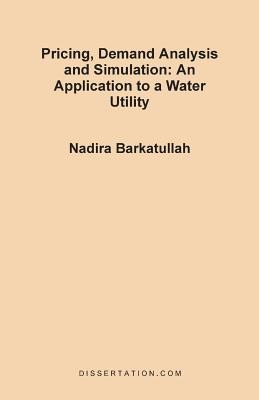
- We will send in 10–14 business days.
- Author: Nadira Barkatullah
- Publisher: Dissertation.Com. - Do Not Use
- ISBN-10: 1581120478
- ISBN-13: 9781581120479
- Format: 14 x 21.6 x 1.2 cm, minkšti viršeliai
- Language: English
- SAVE -10% with code: EXTRA
Reviews
Description
Recent changes in the New South Wales water utilities show a trend towards usage-related pricing, with the aim of providing efficient signals for consumption. This thesis evaluates alternative pricing strategies for water against the criteria of efficiency and equity while maintaining the financial viability of the public utility. First, the water utility cost structure is examined by developing cost functions to estimate short and long-run marginal costs, using a quarterly time-series data from 1970/71 to 1995/96. Second, a residential water demand model is developed using a panel data set (constructed for the analysis), comprising 822 cross-sectional units and 23 quarterly time periods from 1990/91 to 1995/96. The purposes of developing the demand model are to test the sensitivity of water demand to changes in the tariff structure and to use it to simulate the impact of alternative pricing strategies. Third, the simulation model is developed to analyse various pricing reforms using both the cost and demand model results, where the individual welfare and aggregate efficiency gains are determined under each pricing policy. In addition to this, the distributional effects of various tariff structures are examined.
The empirical results of the cost structure estimates are comparable with previous studies. The demand estimation indicates that consumers respond to price, therefore price can be considered as a tool in the implementation of demand management strategies. However, the magnitude of the price elasticity suggests that substantial increases in price would be required to influence demand. Finally, the simulation results show that in the case of movement from the actual tariff structure to a two-part tariff policy (where the usage charge is equal to the short-run marginal cost), leads to highest efficiency gains.
EXTRA 10 % discount with code: EXTRA
The promotion ends in 21d.10:35:53
The discount code is valid when purchasing from 10 €. Discounts do not stack.
- Author: Nadira Barkatullah
- Publisher: Dissertation.Com. - Do Not Use
- ISBN-10: 1581120478
- ISBN-13: 9781581120479
- Format: 14 x 21.6 x 1.2 cm, minkšti viršeliai
- Language: English English
Recent changes in the New South Wales water utilities show a trend towards usage-related pricing, with the aim of providing efficient signals for consumption. This thesis evaluates alternative pricing strategies for water against the criteria of efficiency and equity while maintaining the financial viability of the public utility. First, the water utility cost structure is examined by developing cost functions to estimate short and long-run marginal costs, using a quarterly time-series data from 1970/71 to 1995/96. Second, a residential water demand model is developed using a panel data set (constructed for the analysis), comprising 822 cross-sectional units and 23 quarterly time periods from 1990/91 to 1995/96. The purposes of developing the demand model are to test the sensitivity of water demand to changes in the tariff structure and to use it to simulate the impact of alternative pricing strategies. Third, the simulation model is developed to analyse various pricing reforms using both the cost and demand model results, where the individual welfare and aggregate efficiency gains are determined under each pricing policy. In addition to this, the distributional effects of various tariff structures are examined.
The empirical results of the cost structure estimates are comparable with previous studies. The demand estimation indicates that consumers respond to price, therefore price can be considered as a tool in the implementation of demand management strategies. However, the magnitude of the price elasticity suggests that substantial increases in price would be required to influence demand. Finally, the simulation results show that in the case of movement from the actual tariff structure to a two-part tariff policy (where the usage charge is equal to the short-run marginal cost), leads to highest efficiency gains.


Reviews